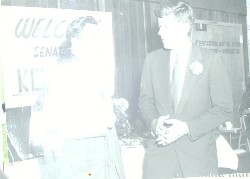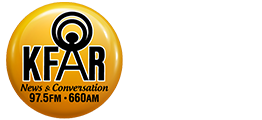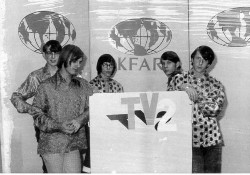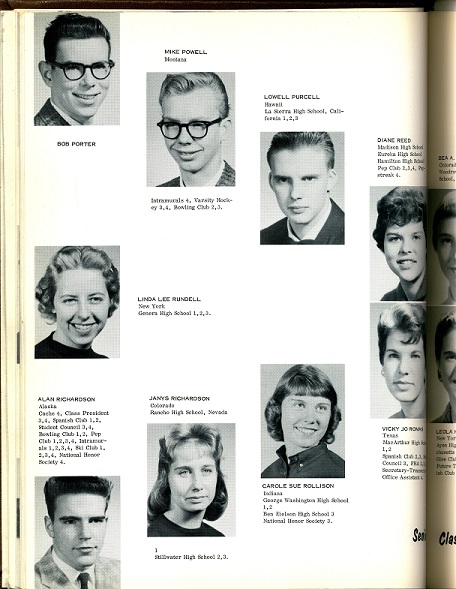 Ray Bonnell / Sketches of Alaska
Ray Bonnell / Sketches of Alaska
FAIRBANKS — Within a few years of commercial radio’s birth in the Lower 48, radio stations began popping up in Alaska. In 1922 the Northern Commercial Company (NC Co.) started KLAY radio station in Fairbanks. Unfortunately for Fairbanks residents, the radio station was short lived. When the NC Co. discovered that in order to keep its license it had to offer airtime on its “company” radio station to other Fairbanks businesses, it decided to turn the transmitter off.
KFQD in Anchorage went on the air in 1924, Ketchikan’s KGBU in 1926, and KINY in Juneau in 1935. Not until Austin “Cap” Lathrop built KFAR in 1939 did radio come back to Interior Alaska.
It was at the prodding of Miriam Dickey, Lathrop’s executive secretary, that Cap decided to start a radio station. He was reportedly “the richest man in Alaska” and could have lived and spent his money Outside. However, he believed in reinvesting his wealth in the Territory, and Dickey convinced him a radio station to serve the needs of Interior Alaska would be a fitting legacy.
The Fairbanks area at that time had a population of about 8,000 people. Augie Hiebert, one of the radio engineers instrumental in setting up the new station, related in his book, “Airwaves over Alaska,” that a 100-250 watt transmitter would have been appropriate for a town of Fairbanks’ size. However, Cap envisioned a radio station that could reach all of Interior Alaska, so he installed a 1,000 watt transmitter. In a promotional book published the first year of the station’s operation, its coverage area was advertised as the Fairbanks vicinity; the railbelt north of Anchorage; the Circle, Kuskokwim, and Iditarod districts; the Seward Peninsula; and the region around Dawson City.
During commercial radio’s infancy, radio stations could choose their own call letters, and Cap held a contest to select the new station’s name. The winning entry was KFAR, which stood for “Key for Alaska Riches.” The station’s slogan became “From the Top of the Word to you.” It began transmitting on Oct. 1, 1939. 
KFAR’s broadcasting studio was on the top floor of the newly completed four-story Lathrop Building on Second Avenue in Fairbanks, and a transmitter building (shown in the drawing) was constructed at mile 5 of the farm road (now Farmers Loop). The transmitter’s 300-foot tower can be seen in the background. The building, constructed of reinforced concrete, was designed by Marcus Pritica, who also designed the Lacey Street Theater for Lathrop. As with the Lacey, the transmitter building is decidedly Art Deco in design.
The 27-foot by 72-foot building, which has 14-foot ceilings in most of the building, is divided into three sections. The middle section housed the stations transmitters and other equipment. To the right of the central section is the radio engineer’s small one-bedroom apartment, and the other side contains a garage and storage area.
The transmitter facility is no longer in service and is currently used for storage by the Fairbanks Golf and Country Club, which has almost as long a history at KFAR. Cap entered into a gentleman’s agreement with the club for a 99-year lease on the 60 acres around the transmitter, and the golf course opened on June 21, 1946.
Borealis Broadcasting Company bought the radio station in the 1980s, and in 1989 sold the Farmer’s Loop property to the golf club. According to borough property records, the old transmitter building has settled considerably over the years, but is still in fairly good condition. Golf course manager, Matt Taylor, told me that some day the club would like to convert the building into its clubhouse.
Ray Bonnell is a freelance artist, writer and longtime Fairbanks resident. See more of his artwork at www.pingostudio.us.
Sources: • “Airwaves over Alaska, the story of Pioneer Broadcaster, Augie Hebert.” as told by his daughter, Robin Ann Chlupach. Sammamish Press. 1992
• “Alaska’s First Homegrown Millionaire, Life and Times of Cap Lathrop.” Elizabeth Tower. 2006
• Conversation with Matt Taylor, Fairbanks Gold Club manager
• “KFAR Keybook of Interior Alaska.” Midnight Sun Broadcasting Company. 1939
• “King of clubs: 50 years of swinging times.” Bob Eley. in Fairbanks Daily News-Miner. 6-16-1996
By Sam Friedman sfriedman@newsminer.com
In 1939, Fairbanks had no radio station and the only other radio came from distant stations in Juneau and Nome. That year, businessman Austin “Cap” Lathrop decided to build a station at the site of what’s now Fairbanks Golf Course on Farmers Loop. Lathrop already owned businesses, including the Fairbanks Daily News-Miner and the Empress Theatre, and he was more than 70 years old when he decided to go into radio.
The first broadcasters had to contend with interference from the Aurora Borealis and rebroadcast news picked up from far-away shortwave stations. The station was the only local radio station for decades in Fairbanks. Interior listeners learned about the 1941 Pearl Harbor attack and the 1967 Fairbanks flood over the radio waves of KFAR.
KFAR later expanded into television. Augie Hiebert, one of Lathrop’s original KFAR employees, went on to become a television pioneer in Alaska, founding Anchorage’s KTVA and KTVF in Fairbanks.
 KFAR RADIO News & Conversation
KFAR RADIO News & Conversation


